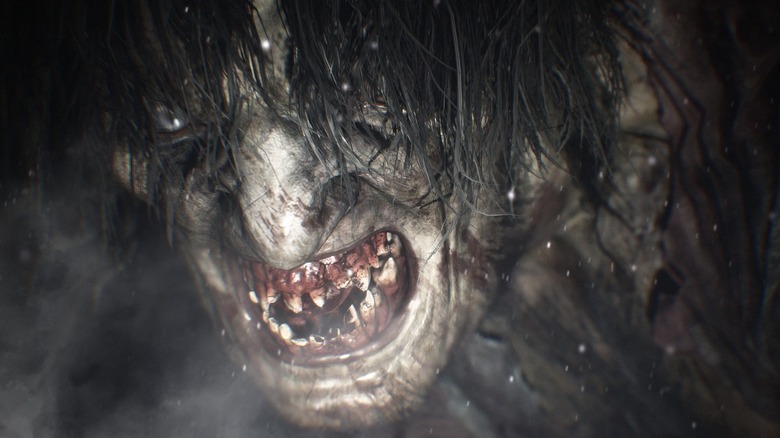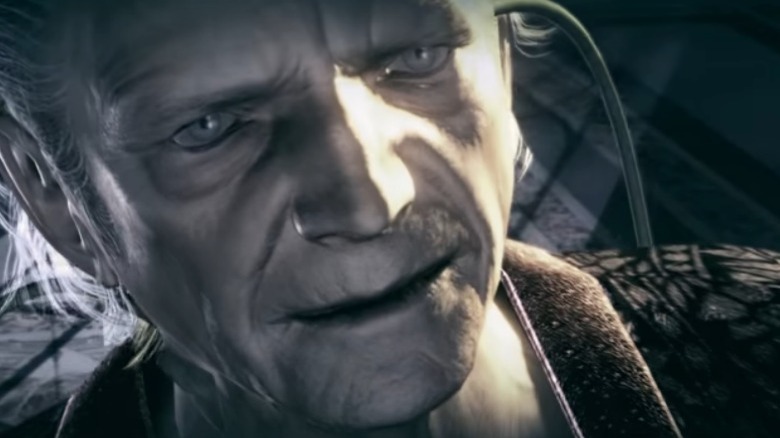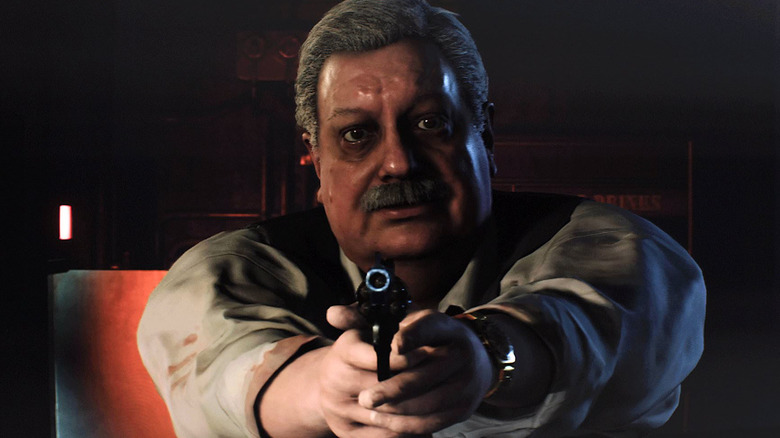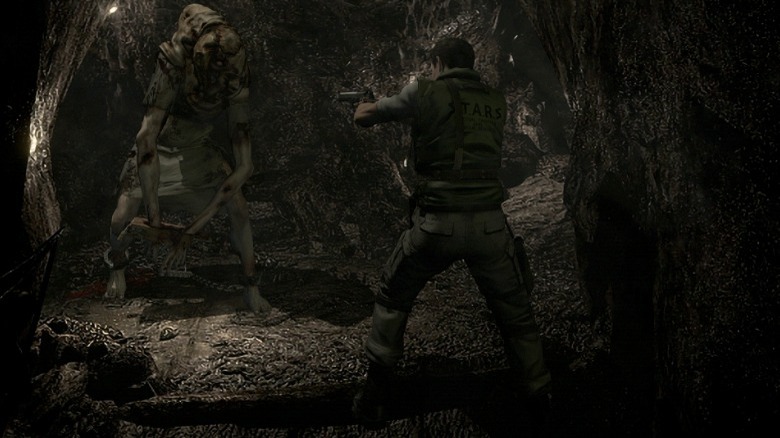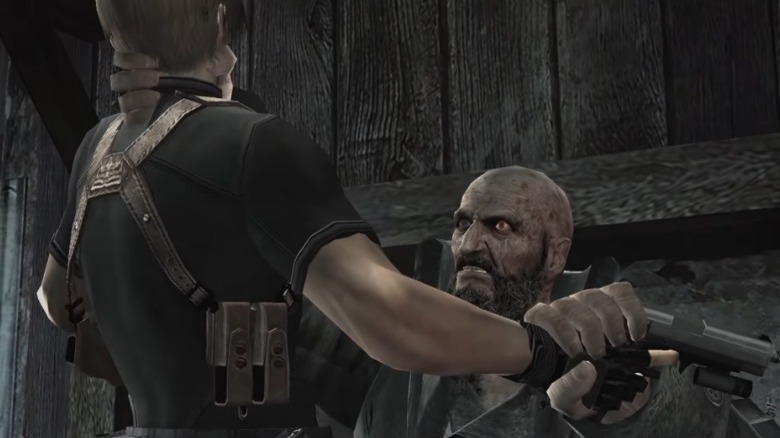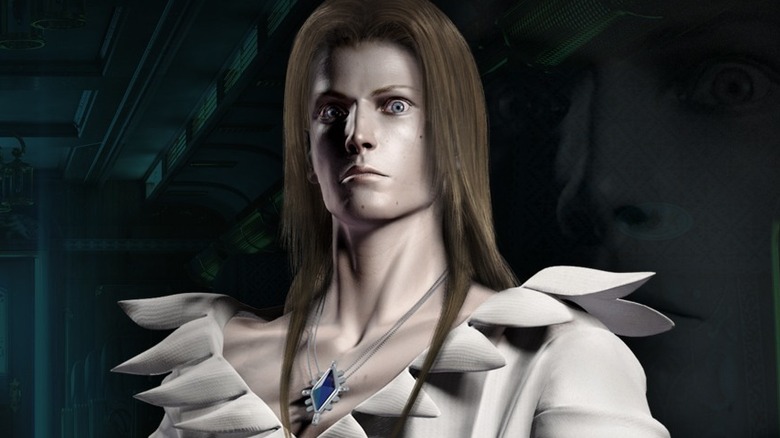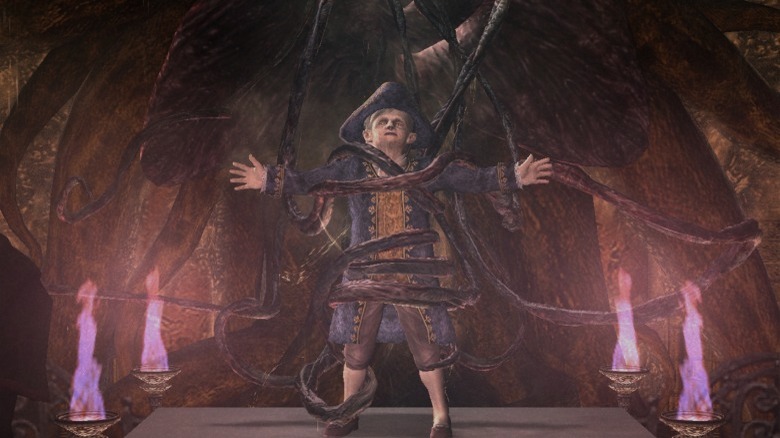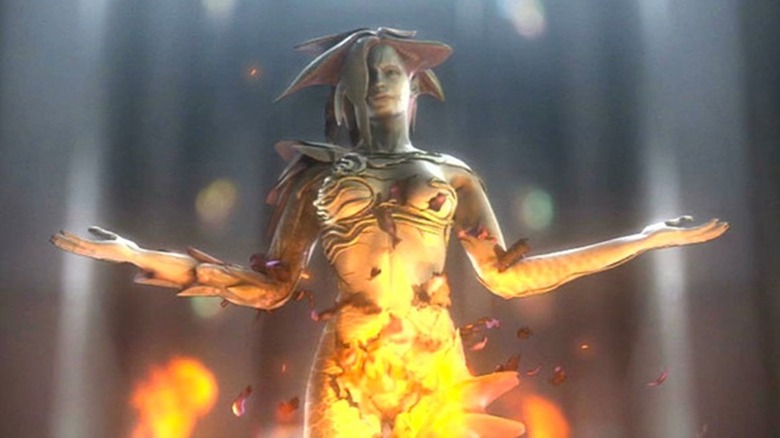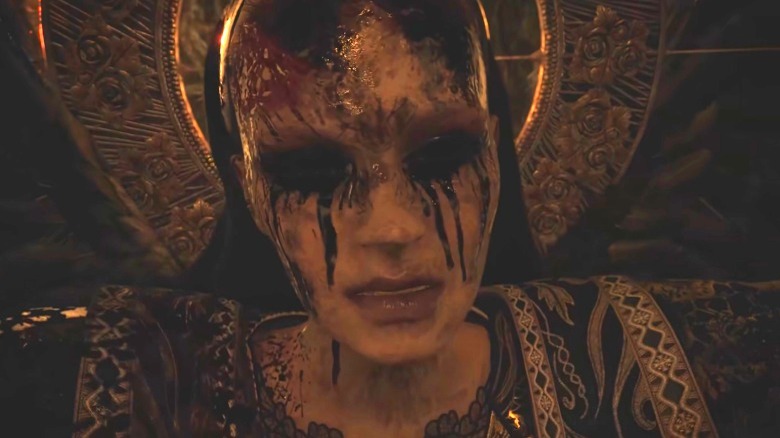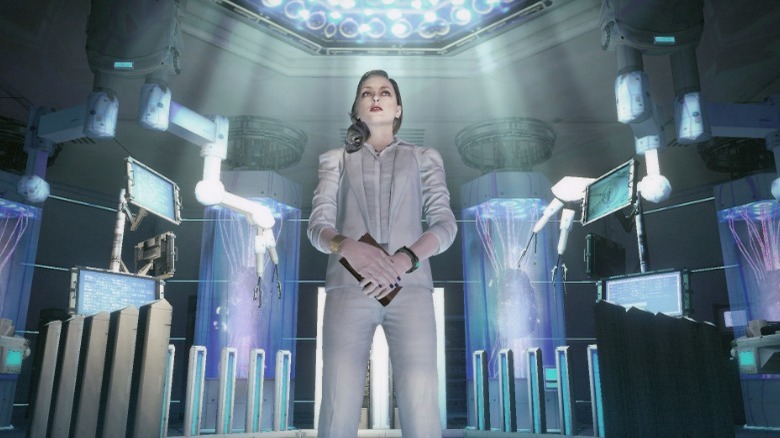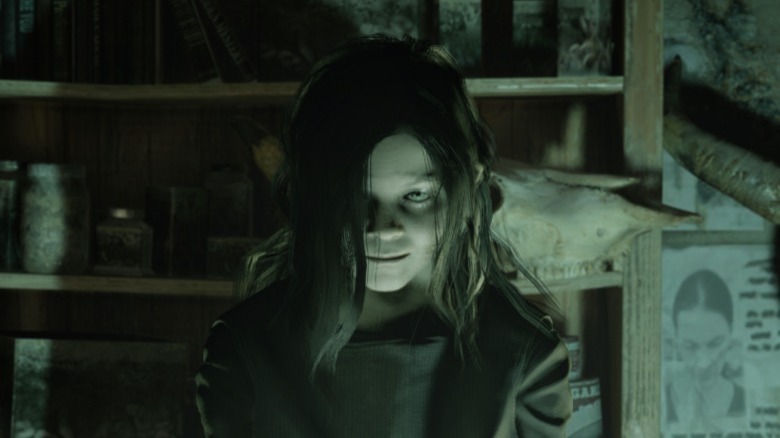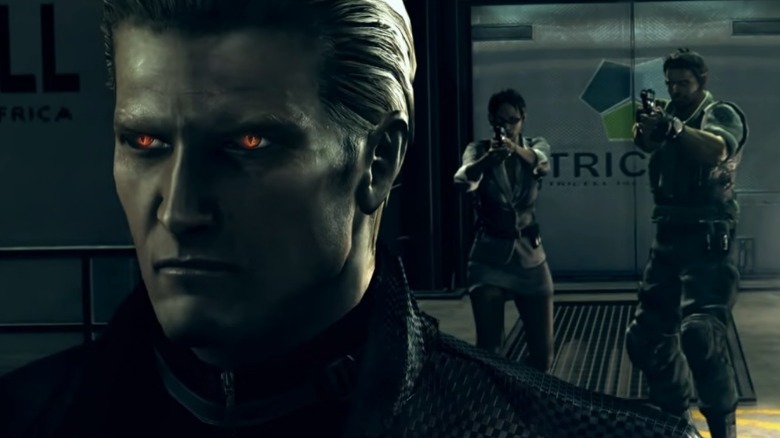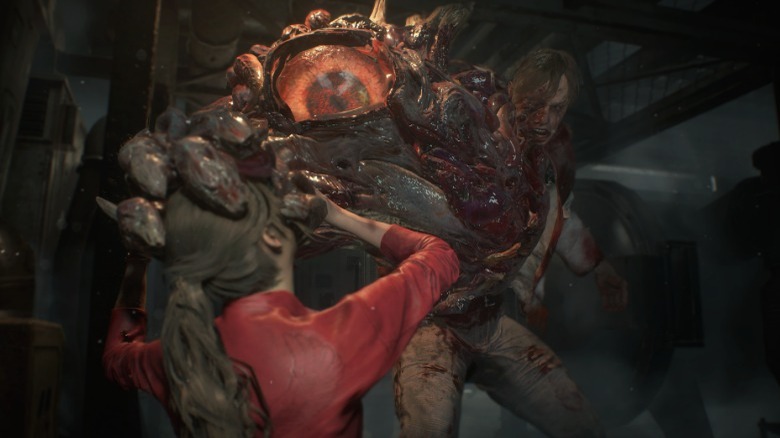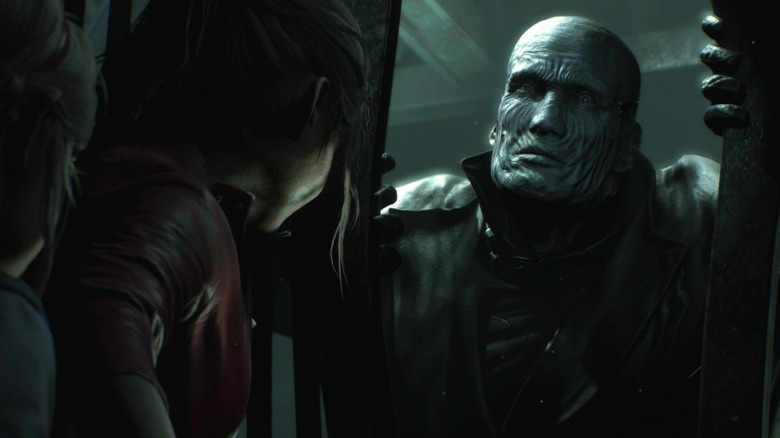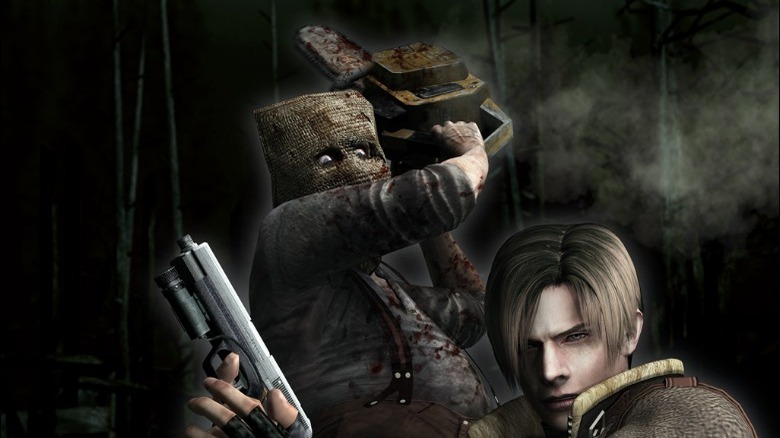The Scariest Resident Evil Villains Ranked
In most zombie media, the meat of the story lies in what people will do to survive, not the zombies' origins. Morality only goes so far when you're staring down a shambling wall of rotting flesh and teeth. To mangle a famous quote from author Jim Butcher, "You don't have to run faster than the zombie horde to get away. You just have to run faster than the guy next to you." Of course, "Resident Evil" isn't like most zombie media.
In "RE," the origin of the zombie outbreak is front and center: An evil organization using mutagenic viruses to fuel their dreams for a eugenics-powered future. When a company is so morally bankrupt it is literally in the business of death, you're likely to find a lot of villains in its employ, many of whom will gladly eat each other alive — and that's before they're transformed into the mindless undead.
Since "Resident Evil" is over 25 years old, the franchise has trudged through a veritable cloning lab worth of villains. Not all of them have had the same impact on the story (or players) as others, so that's why it's worth taking a look at some of the scariest.
Warning: This article includes spoilers for several "Resident Evil" games.
14. Oswell Spencer
What could convince a successful pharmaceuticals, cosmetics, and health food organization like the Umbrella Corporation to enter the lucrative world of biological weapon manufacturing? Well, it turns out that the company's first products were zombies and zombie-affiliated accessories for the black market, making its founder directly responsible for the events in "Resident Evil."
In the late 1960s, Oswell Spencer started Umbrella with one goal: create a new world order populated by virus-enhanced superhumans who will view him as their god. Naturally, he carried out every terrifyingly evil trick in the book to make sure his dream came to fruition. Spencer kidnapped children, trained them, and infected them with a virus once they reached adulthood. He sowed dissent among his subordinates and friends and assassinated many of them. He even became a war profiteer. No crime was beneath Spencer and his insidious desires.
Unfortunately, much of Spencer's intimidation factor was eventually lost to the ravages of old age. By the time players catch up with him, he's a feeble old man, barely clinging to life through sheer arrogance and a number of machines. Still, despite his age, Spencer gives off a slight air of malice, and you can't shake the feeling that if he were a younger, more able-bodied man, you probably wouldn't live long in his presence. Moreover, despite its non-canonicity, "Resident Evil: Resistance" demonstrates that time has not softened his Machiavellian tendencies.
13. Brian Irons
Since the Umbrella Corporation is about as one-dimensionally evil as a "Captain Planet" villain, it would be natural to assume virtually everyone else in the franchise would be cast in a heroic light. However, "Resident Evil" is supposed to be a "verisimilitude of a realistic world," according to series designer Yoshiaki Hirabayashi — and the real world isn't a cut and dry battle between good and evil. Sometimes, bad people worm their way into positions of power and sit right under the law's nose, or even control where that nose points.
Since Raccoon City police chief Brian Irons takes bribes from Umbrella, you would think he'd be an example of how that company can corrupt upstanding people. However, the games explain he was never good to begin with. "Resident Evil" games that feature Irons show he is obsessed with taxidermy, but hunting and stuffing animals isn't enough to satisfy him. No, lore-dumping notes imply he has actually taxidermied human women before, and several pre-zombie outbreak serial murders might have been his doing.
Irons never mutates into a horrific monster; the closest he gets to that honor is serving as an unwilling G embryo host. But he sort of makes up for that shortcoming by bringing a more realistic and intelligent kind of horror to a series that reserves most of its scares for zombies and mindless test tube abominations.
12. Lisa Trevor
What does it take for a victim of horrific experiments to become a villain in their own right? In many stories, the answer is an unquenchable desire for revenge. In "Resident Evil," the answer is a virus-addled brain and a death-proof body.
Few characters are as tragic (or essential) to the world of "Resident Evil" as Lisa Trevor. The daughter of George Trevor, architect of the infamous Spencer Mansion, Lisa was kidnapped along with her mother and injected with the Progenitor Virus. Through some perverse miracle, Lisa survived and became Oswell Spencer's favorite guinea pig. Her body became a deathless petri dish that spawned countless diseases, and her mind degraded from all the viruses running around her brain. While she was lucid enough to realize that the Umbrella employees who posed as her mother were fakes, Lisa was also insane enough to cut off their faces and stitch them together into a grotesque mask.
Much of Lisa's scare factor and villain status comes from her tragic backstory, as the constant experiments left her deformed in both body and mind. Anyone who fights her knows she actually isn't all that scary in combat. In order to defeat her, all you have to do is push four rocks over a ledge. Honestly, Lisa is more sympathetic and unsettling than full-on terrifying, even if she did have a face only a mother could love — and giant back tentacles.
11. Bitores Mendez
While zombies and the constant fear of low ammo make up a decent chunk of "Resident Evil" scares, the series also relies on a potent amount of body horror. Nothing makes your stomach squirm quite like watching a body bubble into increasingly abstract shapes. But what if someone were physically intimidating even before they transformed into a monster straight out of a David Cronenberg film?
Osmund Saddler is the leader of the Los Illuminados cult in "Resident Evil 4," but the man who helped Saddler get his foot in the door was Bitores Mendez. Once a humble Catholic priest, Mendez traded his faith and humanity for power in the form of the parasitic Las Plagas, which turned him into the bulletproof lovechild of the Hulk and Grigori Rasputin. Unlike most of the series' giant villains, Mendez retains all of his intelligence and linguistic skills, which is scary in and of itself.
His base form is imposing enough, but when lit on fire, Bitores mutates into the stuff of nightmares. His nails lengthen into claws, his shoulder blades birth two extra scythe-like limbs, and his spine elongates into something resembling a centipede. Not only does this transformation make the towering Mendez even taller, but during the ensuing fight, his legs are blown off — however, his torso refuses to give up, even as his lower body stumbles around harmlessly.
Mendez' motivations and personality might not be complex, but his sheer size and disturbing mutation do more than enough heavy lifting.
10. Queen Leech/James Marcus
What is evil? Is it the decision to do something contrary to societal standards of morality, or is it the heinous act itself? Can you call a creature evil when it is working off emotions and desires that aren't its own?
Although Oswell Spencer takes all the credit for founding the Umbrella Corporation and its illegal activities, he had one partner in crime: James Marcus, a brilliant virologist who helped create a new strain of t-Virus. Unfortunately, Marcus' intellect came at the cost of being an obsessive perfectionist. When he didn't get the results he wanted (which was often), he turned to more depraved methods, including experimenting on children and, most importantly, leeches.
After Marcus was assassinated, a small leech entered his body and seemingly resurrected him, resulting in one of the campiest "Resident Evil" villains ever. The revived "Marcus" makes up for the hamminess with a disgusting plot twist: "He" was actually a leech that had eaten the real Marcus' brain and assumed Marcus' form and assimilated his memories. The only thing more terrifying than realizing this leech's motivations were based on a lie is its subsequent transformation into a writhing, undulating final boss.
9. Ramon Salazar
According to the Dreamworks movie "Megamind," the biggest difference between a regular villain and a super villain is "presentation." "Resident Evil" doesn't always dial up the presentation factor of its villains, but when it does, the result is more intimidating and scarier than characters who just rely on their size.
One of the most memorable characters from "Resident Evil 4" is Ramon Salazar, the diminutive lord of a nearby castle. Like Bitores Mendez, Salazar is a loyal follower of Osmund Saddler. Unlike the stoic Mendez, however, Salazar often livens up his scenes by cackling with glee, especially whenever he turns his home's booby traps — including a giant statue of himself — against Leon Kennedy.
Salazar's actions are all the more terrifying since he does them in the name of atonement. He was swayed by Saddler's claims that his family committed horrible "sins" in the past (i.e., sealed the mines that contained Las Plagas spores), and Salazar now happily commits evil acts to compensate for his family's past heroism. It's horrifying the lengths some villains will go to when they believe they are in the right.
Of course, like any good "Resident Evil" boss, Salazar has one final trick — er, transformation — up his sleeve. Unlike other bosses that are just one giant, mutated monster, Salazar's final form is a disgusting, bubbling chimera consisting of himself, a Verdugo bodyguard, and the Queen Plaga.
8. Alexia Ashford
"Resident Evil" has two recurring themes: Stay away from zombies and stay even further away from anyone who believes in eugenics. This also applies to anyone and anything non-zombie that these people might create. Case in point: Alexia Ashford.
Alexia is the "daughter" of Umbrella geneticist Alexander Ashford. In truth, she's a genetically modified clone of Alexander's family matriarch, Veronica Ashford. Alexia was designed to be superior to all other humans, and although she was a child prodigy, her inhuman intelligence made her hopelessly psychotic. She spent most of her life viewing virtually all other humans as "ignorant masses" who were only fit to serve as her guinea pigs. One of her first human experiments turned her father into the twisted creature known as "Nosferatu."
Alexia's mind is terrifyingly sharp, but her body is on a whole other level. Thanks to her genius intellect, she was able to harness the full power of the t-Veronica Virus — the same strain she used to transform her father. She metamorphosed into a hideous insect-like hybrid with combustible blood. As scary as that sounds, it gets worse: she was able to fight the single most dangerous individual in "Resident Evil" history, Albert Wesker, to a standstill. Since Wesker has proven nearly impossible to kill, that feat is as impressive as it is terrifying, and it demonstrates the threat Alexia posed to the world.
7. Mother Miranda
Almost every villain in the "Resident Evil" franchise participates in either the moneymaking or apocalyptic aspects of Umbrella's ultimate goals, but not Mother Miranda. She wants something far more relatable, which makes her actions all the more heinous.
In "Resident Evil Village," the messianic figure of Mother Miranda only dreams of reviving her daughter who died during the Spanish flu pandemic of the early 1900s. Normally, a "Resident Evil" character would revive someone via cloning, but Miranda took a different approach. She planned to upload her daughter's consciousness into a Mold-infested host. Yes, the very same Mold players encounter in "Resident Evil 7." To achieve this goal, Miranda gladly sacrificed an entire village.
For over 100 years, Miranda used the titular village of "Resident Evil 8" as her own genetic playground. She infected whole generations of families with the Mold (or to be more specific, the parasitic Cadou) and tricked them into worshipping her for it. However, she only saw them as discardable pawns. Miranda also took the same approach to her more promising infectees, despite their undying loyalty (with the exception of the villainous Karl Heisenberg), and she positioned the well-intentioned Ethan Winters as her gullible executioner.
Miranda might transform several times during the game's final battle, but her physical form pales in comparison to her twisted motivations and dark soul. The road to hell is paved with good intentions, and because of her actions, Miranda is going straight to the ninth circle.
6. Alex Wesker
The Wesker "family" is the result of lab-grown abuse and eugenics. As fans of the series have learned, the only good Wesker is a dead one — mostly because players only encounter undeniably evil Weskers.
The "sister" of the big bad Albert Wesker, Alex Wesker is nowhere near as famous as her brother, but she is every bit as demented. Like Albert, Alex became a high-ranking Umbrella Corporation researcher, but when she left the company, she journeyed to a destitute island and transformed it into her own laboratory of horrors. All of the disfigured monstrosities in "Resident Evil Revelations 2" are the result of her experiments. Why, you ask, did Alex shove bear traps into dog heads and staple together corpses? Because she was dying and wanted to create a host that literally could not experience fear and could contain her digitized mind.
After Alex accomplished her goal of cheating a slow and agonizing death, Alex's original body mutated into a giant, gangly abomination with a prehensile, exposed spine and an unhealthy obsession with killing her copied consciousness' host. The logistics of moving an external spine without connective tissue are terrifying enough, and her new body finally made Alex look as monstrous as she acted.
5. Eveline/The Baker Family
A key component of zombiedom is the lack of high brain function. Most zombie diseases, including the t-Virus, dissolve a victim's gray matter, only leaving their most primal and predatory instincts intact. The parts of the brain that made up their memories and personality are turned to mush. That's why those who succumb to Eveline and her Mold experience a far more terrifying fate, since they are conscious to witness their actions but are helpless to stop themselves.
In "Resident Evil 7," Eveline spewed the Mold that ate the innocent victims who became the Molded. This Mold also turned the Baker family into superpowered, immortal hillbillies. However, Eveline's power took a devastating toll on her body. Without a special drug, her body aged 100 years in the span of three.
The true horror of Eveline comes from the Mold she carries, which, according to (a possible hallucination of) Jack Baker is actually a torturous form of mind control. Essentially, anyone under Eveline's sway can't resist the urge to do what she tells them. Granted, characters like Mia demonstrate that mind control victims can fight back, but it's so difficult that she prefers an axe to the neck. However, thanks to the Mold's regenerative properties, death doesn't let Eveline's victims escape her grasp for long, which makes her power one of the most terrifying in "Resident Evil."
4. Albert Wesker
What's scarier than a person with aspirations of world domination? Someone with the power to accomplish those ambitions and comes terrifyingly close to doing so.
Albert Wesker is essentially the main villain of the "Resident Evil" franchise, at least up until "Resident Evil 5." An unrepentant sociopath with a god complex, Wesker believes the only way to save the world is to burn it down and let a chosen few who win the genetic lottery (officiated by a highly mutagenic virus) create a new world order.
Unlike most villains with delusions of grandeur, his megalomania is no figment of his imagination. Thanks to his upbringing and mutation, Wesker is truly mentally and physically superior to everyone on the planet. He can dodge bullets "Matrix"-style, toss missiles as if they were javelins, and stop rockets one-handed. Not even a dip in lava can stop him, especially after he fuses with the Uroboros Virus.
Thanks to his genius intellect and powers that would elevate him to god status in other media (especially comic books), Wesker had victory within his grasp, coming far closer than most other villains. That terrifying achievement places him in a league well above most "Resident Evil" villains, as well as most villains in general, regardless of fictional universe.
3. William Birkin
Most viruses in the "Resident Evil" universe result in the kinds of fates that make you want to say, "I wouldn't wish that on my worst enemy." This is especially true when the disease and its infection are used for narrative poetic irony, as is the case with William Birkin.
Even before he started mutating, William Birkin was truly a monster. One of the Umbrella Corporation's chief researchers, Birkin created the G-Virus, but he also had his hands in many of the company's virulent pies. For instance, Birkin transformed the t-Virus into a zombie-making nightmare by injecting Lisa Trevor with Ebola, and he also produced many of Umbrella's Bio Organic Weapons, including the Hunter ɑ.
Before Birkin succumbed to numerous bullet wounds, he "saved" his own life by infecting himself with the G-Virus. This robbed him of his terrifying intellect and instead turned him into a horrifying monster that mutated every five minutes. Not only is the resulting "G-Birkin" one of the most grotesque monsters in "Resident Evil" history, its level of intelligence is questionable. While Birkin's wife insists G-Birkin is mindless, a number of its forms demonstrate some levels of higher thinking, using tools and crying out for his daughter, Sherry.
Was Birkin conscious as the G-Virus dissolved his brain and turned his face into a pectoral muscle, or were the G-Birkin's seemingly human-like actions the dying echoes of his once-great mind? This debate alone solidifies Birkin's place as one of the absolute scariest villains in "Resident Evil ” history.
2. Mr. X
Most game bosses face a problem: They are designed to intimidate players, and gamers can build up an immunity if they spend too much time with one. The "Resident Evil 2" remake avoids this issue with Mr. X and even elevates him above most bosses in the franchise.
In "RE2," Mr. X is the ultimate enemy. To quote Kyle Reese from "The Terminator," Mr. X "can't be bargained with; it can't be reasoned with. It doesn't feel pity or remorse or fear, and it absolutely will not stop, ever, until you are dead." You can only put Mr. X down by pumping him full of an ungodly amount of ammo, and that only lasts a few seconds before he gets back up. The worst you can do to him is blow off his hat.
Unlike the Tyrant seen in the original "Resident Evil 2" (and Nemesis from the "Resident Evil 3" remake), the "RE 2" remake's Mr. X patrols the police station, so he can pop up at the most inopportune times and places. Not only do players need to stay on their toes and deal with zombies and Lickers, but they also have to keep one eye and ear peeled for him, since he can't be stopped until his dedicated boss fight.
Since you never know when or where Mr. X will appear, this changes the enemy encounter rules entrenched in the franchise since the first "Resident Evil," thereby heightening the tension more than any other "RE" game.
1. Doctor Salvador
Most games ease players into the action, but not "Resident Evil 4." That title tosses gamers into the deep end, and the Chainsaw Man, better known as Doctor Salvador, is the shark prowling at the bottom.
During the first chapter of "Resident Evil 4," players mostly have to contend with regular Ganados. They're slow, they moan, and their heads explode if you hit them just right. This is all standard zombie (or zombie-adjacent) stuff, but then Ganados start to attack in droves, and you hear ... a chainsaw. That is the sound of Doctor Salvador, the game's first mini-boss, and he is infinitely more dangerous than rank and file Ganados because of one small (but important) detail: He can decapitate Leon Kennedy. It doesn't matter how much health Leon has; Doctor Salvador cuts it all away with a single attack.
Not only do players have to stare down Doctor Salvador and his burlap sack mask within the first chunk of "RE4," but he is one of the few non-boss enemies in the game and franchise with an instant death attack. Plus, since he's a mini-boss, Doctor Salvador is more durable than other enemies, so it's easier for him to close the gap and introduce his chainsaw to Leon's neck.
Doctor Salvador is a beginner's trap who haunts gamers for the rest of their campaign, straining their ears for the telltale sound of a chainsaw. That paranoia is well founded, because gamers will eventually meet his spiritual successors, the Chainsaw Sisters.

